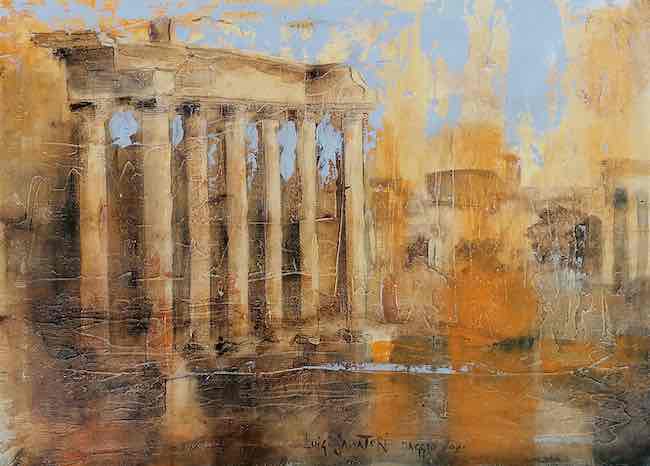Esistono artisti che hanno uno sguardo realistico sulla realtà osservata, che si sentono affascinati dal dettaglio, dall’insieme che possa essere testimone dello scorcio o del frangente ritratto; altri invece che affondano la propria emotività in atmosfere completamente distaccate da ciò che è contingente perché ciò che conta è la sostanza, l’essenza del sentire a prescindere dal riferimento da cui prende spunto. E poi vi sono quelli che sono in grado di lasciar vagare il proprio sguardo sui panorami quotidianamente davanti ai loro occhi andando però a scavare nelle loro profondità, nei significati che hanno, e hanno avuto, nel corso del tempo, testimoni di un continuo scorrere che ha permesso loro di assistere ai cambiamenti che la società ha subito, e continuerà a subire, dall’alto della loro immortalità e del loro svettare sulla vita. Lugi Salvatori appartiene a quest’ultima categoria di artisti, quelli che grazie alla loro spiccata sensibilità sono in grado di dare voce all’essenza che dalla visione di edifici e scorci fuoriesce.
Nei primi ventenni del Ventesimo secolo l’arte mondiale ha subìto un radicale cambiamento di rotta rispetto al passato, lasciando emergere quelle innovazioni che presero il nome di avanguardie ma che di fatto diedero vita a movimenti pittorici in grado di segnare il passo e costituire un ponte tra passato e futuro; da un lato alcuni vollero mantenere un forte legame con la figurazione pur sovvertendone il senso e introducendo l’analisi sull’interiorità e sulla psiche umana, come il Surrealismo, oppure sul mistero del silenzio e la destabilizzazione dello sguardo in cerca di contestualizzazioni con la realtà visibile tipico della Metafisica, ma anche sull’esigenza di mettere al centro la figura umana e la sua solitudine, i suoi disagi esistenziali come nel nuovo Realismo americano che fu ripreso, nella struttura paesaggistica, nelle opere degli artisti aderenti alla Scuola romana, più orientati a mediare tra gli estremi del Post-Cubismo e un apparato pittorico più tradizionale. Di contro invece emerse un nutrito gruppo di creativi che intendevano affermare la supremazia del gesto plastico purificandolo da qualsiasi riferimento alla realtà oggettiva, inizialmente rifiutando persino la soggettività dell’esecutore dell’opera, ma successivamente, con l’affermarsi dell’Espressionismo Astratto recuperando e rendendo centrale l’emozione, quel sentire interiore in grado di fare la differenza tra una distaccata osservazione e un coinvolgimento totale da parte del fruitore dell’opera. Tra i due estremi è possibile collocare l’Espressionismo che pur restando fortemente legato alla figurazione, rifiutava però un approccio estetico e formale tradizionale dando rilevanza assoluta alla necessità di connessione tra il sentire e il vedere, assecondando pertanto la gamma cromatica, sostanzialmente irreale, al percepito da parte dell’artista nel momento di realizzazione sulla tela del suo intento espressivo. L’artista romano Luigi Salvatori, con alle spalle un lungo percorso artistico e attuale presidente dell’Associazione Cento Pittori di via Margutta, personalizza le esperienze delle correnti pittoriche del passato dando vita a un suo linguaggio suggestivo in cui l’apparato figurativo si mescola e a volte persino si nasconde dietro le macchie di astrazione che sembrano costituire il velo della memoria, lo scrigno interiore che fotografa non in maniera realistica bensì attraverso il filtro di una sensazione, di una percezione che resta scolpita.
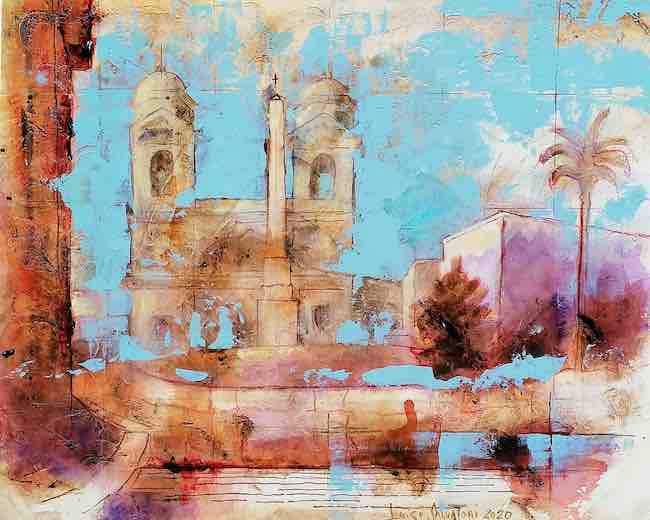
La sovrapposizione diviene dunque una patina emozionale attraverso cui lo sguardo interiore si pone nei confronti di panorami romani, dunque costantemente sotto i suoi occhi e di cui tende a chiedersi quanta vita sia passata sotto i ponti, davanti ai monumenti e alle cupole che hanno permesso di attribuire a Roma l’appellativo di città eterna. Il cromatismo è prevalentemente bicromo pur essendo arricchito da sfumature e dal tratto grafico attraverso cui Luigi Salvatori sembra voler evidenziare i confini, i profili di palazzi storici che si stagliano nell’atmosfera silenziosa forse vicina all’alba, quando il rumore del traffico non viola la bellezza permettendo di cogliere particolari che poco più tardi potrebbero essere offuscati dal passaggio perpetuo di automobili, pullman, motorini che affollano ogni singolo angolo della città.
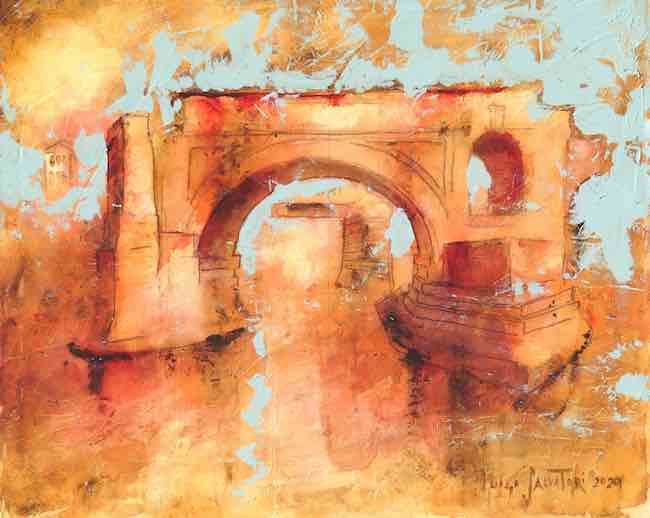
L’arancio sfumato o il giallo ocra si affiancano e invadono l’azzurro del cielo, quasi come se la rappresentazione delle immagini evocate in maniera sognante dall’artista necessitasse di incontrare la realtà, quella del cielo sereno e azzurro intenso che contraddistingue la maggior parte delle giornate della capitale.
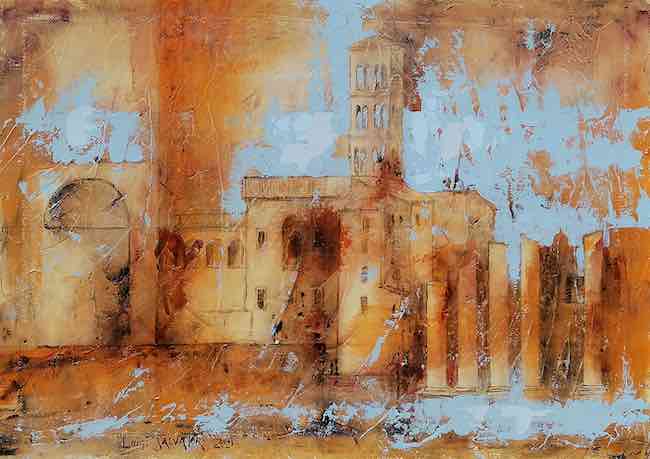
Ma ciò che suscita maggiore riflessione nell’osservatore è quel domandarsi se gli edifici senza tempo, le testimonianze di una civiltà lontana che sembra continuare a sussistere nelle atmosfere contemporanee, vogliano in qualche modo vegliare sul presente, o costituiscano un monito nei confronti della civiltà odierna a non dimenticare di rispettare la bellezza soprattutto quando non è fine a se stessa, quando riesce a toccare l’anima proprio perché simbolo di tutto ciò che, pur essendo stato pensato e costruito dall’uomo, è riuscito a sopravvivergli, malgrado i conflitti, malgrado lo scorrere dei secoli, malgrado tutto.
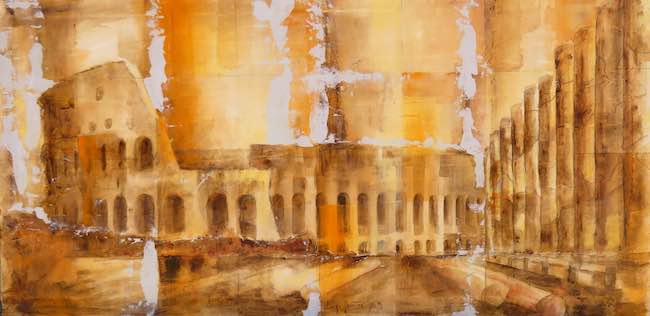
Nella tela I resti del Tempio di Venere sul Colosseo lascia emergere la capacità contemplativa di Luigi Salvatori, quel suo porsi all’interno di una dimensione spazio temporale diversa perché guidata dalla sensibilità che lo contraddistingue e che gli permette di mettere in evidenza tutto ciò che viene quotidianamente, tanto quanto distrattamente, osservato da milioni di persone, quasi come se abituandosi alla bellezza non le si desse più la dovuta importanza. Il focus dell’artista invece si mantiene in costante osservazione delle sfumature e soprattutto di quella capacità si sospendere lo scorrere dei giorni, dei mesi, degli anni, quel tempo che tanto sfugge all’essere umano quanto invece sembra restare immobile dal punto di vista di quei guardiani benevoli che ogni mattina e ogni sera assistono al riempirsi e allo svuotarsi delle città.
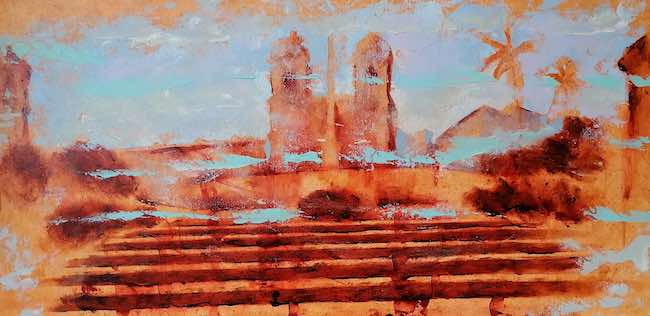
In Il desiderio dell’invisibile, Scalinata Trinità dei Monti, l’artista ascolta e interpreta tutte quelle energie sottili che costituiscono il fascino non tanto della costruzione in sé quanto della magia romantica di cui la scalinata e il palazzo e l’obelisco che la sovrastano sono avvolti; il rosso rame trascina letteralmente l’osservatore nella dimensione nostalgica e sognante di un frangente indimenticabile, un attimo che si insinua tra realtà e ricordo rarefacendo l’aspetto contingente, consegnandolo all’immortalità dell’immaginazione, della possibilità che tanta armonia possa essere rivolta solo al fruitore momentaneo di quel panorama.
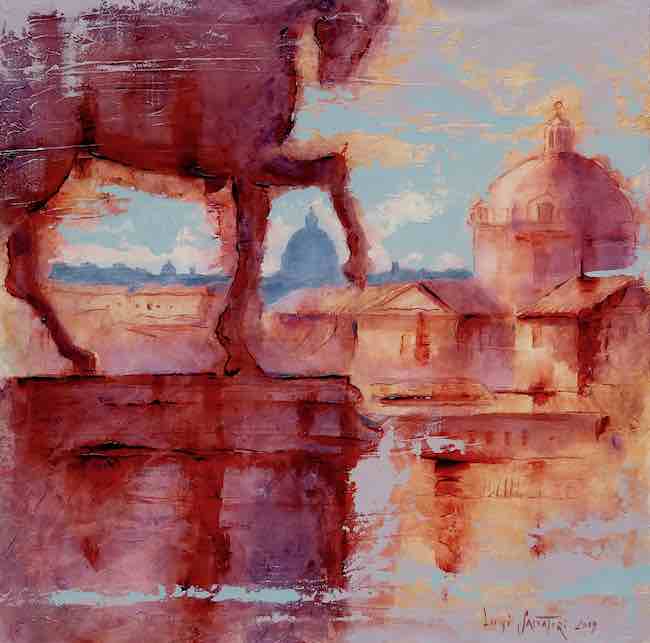
Nell’opera Roma dal Vittoriano emerge un’altra caratteristica di Luigi Salvatori, quell’incidere la tela con un lieve grattage che sembra accentuare l’immortalità dei monumenti su cui si posa il suo sguardo, quasi come se il risultato finale del dipinto dovesse sottolineare, ancor più che in altri, quella sospensione in una dimensione oltre il tempo ma che, di contro, sottintenda anche il suo scorrere inesorabile lasciando le sue tracce ovunque si posi anche su ciò che riesce a resistere alla sua azione; il senso della suggestione diviene ancor più intenso proprio in virtù di quelle tracce, di quelle striature che sfumano i confini perché appartenenti al ricordo, alla rievocazione di qualcosa osservato con attenzione in un frangente particolare e che, inevitabilmente, va a far vibrare le corde emotive di chiunque quel dettaglio l’abbia avuto davanti agli occhi almeno una volta.
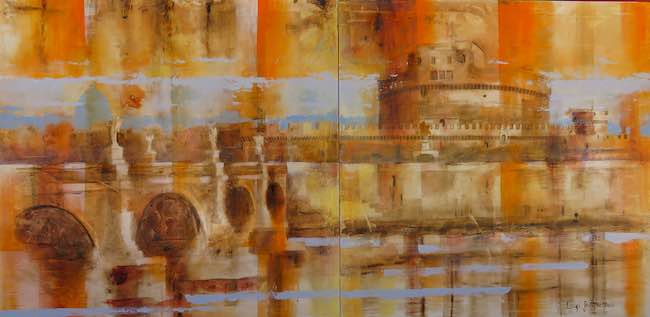
E ancora nel dittico Lungo il Tevere che scorre lento l’artista infonde all’opera l’effetto del ricordo, della nostalgia, enfatizzando l’effetto seppia delle antiche fotografie, quelle tenute gelosamente in un angolo del cassetto poiché legate a quella memoria emotiva che non vuole essere dimenticata né sostituita dal nuovo. Dal silenzio del presente sospeso alla voce del passato, sembra essere questa la linea guida della produzione artistica di Luigi Salvatori che espone dieci sue tele presso lo storico ristorante Locanda dell’Angelo, ristorante di fronte a Ponte Sant’Angelo che ha scelto di arricchire le sue pareti con le suggestive opere dell’artista sul tema paesaggi e magie di Roma. Figlio d’arte, i nonni erano entrambi pittori, Luigi Salvatori si divide tra la sua professione di architetto e quella di artista, ha all’attivo la partecipazione a numerose mostre collettive ricevendo premi e menzioni e le sue opere sono inserite nei più importanti volumi italiani dedicati all’arte contemporanea, oltre a essere presidente dell’Associazione Cento Pittori di via Margutta, realtà storica consolidata da decenni sul territorio romano.
LUIGI SALVATORI-CONTATTI
Email: arch.luigisalvatori@gmail.com
Sito web: www.luigisalvatori.it
Facebook: https://www.facebook.com/luigi.salvatori.372
Instagram: https://www.instagram.com/luigisalvatori.art/
Evocations and suggestions in the artworks on suspended time by Luigi Salvatori
There are artists who have a realistic gaze on the reality they observe, who feel fascinated by the detail, by the whole that can bear witness to the foreshortening or the juncture portrayed; others, on the other hand, who sink their emotionality into atmospheres completely detached from what is contingent because what counts is the substance, the essence of feeling regardless of the reference from which it takes its cue. And then there are those who are able to let their gaze wander over the panoramas daily before their eyes while delving into their depths, into the meanings they have, and have had, over time, witnesses of a continuous flow that has allowed them to witness the changes that society has undergone, and will continue to undergo, from the height of their immortality and their soaring over life. Lugi Salvatori belongs to the latter category of artists, those who are able to give voice to the essence that emerges from the vision of buildings and views.
In the first two decades of the 20th century, world art underwent a radical change of course compared to the past, allowing to emerge those innovations that took the name of the avant-garde, but which in fact gave rise to pictorial movements capable of marking the pace and building a bridge between the past and the future; on the one hand, some wanted to maintain a strong link with figuration while subverting its meaning and introducing an analysis of interiority and the human psyche, such as Surrealism, or the mystery of silence and the destabilisation of the gaze in search of contextualisation with visible reality typical of Metaphysics, but also on the need to focus on the human figure and its loneliness, its existential hardships as in the new American Realism that was taken up, in its landscape structure, in the works of the artists belonging to the Roman School, more oriented towards mediating between the extremes of Post-Cubism and a more traditional pictorial apparatus. On the other hand emerged a large group of creatives who intended to assert the supremacy of the plastic gesture by purifying it of any reference to objective reality, initially rejecting even the subjectivity of the artwork’s executor, but later, with the affirmation of Abstract Expressionism, recovering and centralising emotion, that inner feeling capable of making the difference between a detached observation and a total involvement on the part of the work’s viewer. Between the two extremes one can place Expressionism, which, while remaining strongly linked to figuration, rejected a traditional aesthetic and formal approach, giving absolute importance to the need for connection between feeling and seeing, thus favouring the substantially unreal chromatic range to the artist’s perception at the moment of realising his expressive intent on canvas. The Roman artist Luigi Salvatori, with a long artistic career behind him and current president of the Cento Pittori di via Margutta Association, personalises the experiences of past pictorial currents, giving life to his own suggestive language in which the figurative apparatus is mixed and at times even hides behind the patches of abstraction that seem to constitute the veil of memory, the inner treasure chest that he photographs not realistically but through the filter of a sensation, of a perception that remains sculpted. The superimposition thus becomes an emotional coating through which the inner gaze is placed on Roman panoramas, thus constantly before his eyes and of which he tends to wonder how much life has passed under the bridges, in front of the monuments and domes that have allowed Rome to be called the eternal city.
The colour scheme is predominantly two-tone, although it is enriched by nuances and the graphic line through which Luigi Salvatori seems to want to emphasise the borders, the profiles of historic buildings that stand out in the silent atmosphere perhaps close to dawn, when the noise of traffic does not violate the beauty, allowing to capture details that a little later might be obscured by the perpetual passage of cars, buses, mopeds that crowd every single corner of the city. Faded orange or yellow ochre flank and invade the blue of the sky, almost as if the representation of the images dreamily evoked by the artist needed to meet reality, that of the clear, deep blue sky that characterises most days in the capital. But what arouses greater reflection in the observer is the question of whether the timeless buildings, the vestiges of a distant civilisation that seem to continue to exist in contemporary atmospheres, are somehow meant to watch over the present, or constitute a warning to today’s civilisation not to forget to respect beauty above all when it is not an end in itself, when it succeeds in touching the soul precisely because it is a symbol of everything that, even though having been conceived and built by man, has managed to survive him, despite conflicts, despite the passage of centuries, despite everything. In the painting The Remains of the Temple of Venus on the Colosseum, emerges Luigi Salvatori’s contemplative capacity, his placing himself within a different space-time dimension because it is guided by the sensitivity that distinguishes him and allows him to highlight everything that is daily, as much as distractedly, observed by millions of people, almost as if becoming accustomed to beauty no longer gave it due importance.
Instead, the artist’s focus remains on the constant observation of nuances and above all of that ability to suspend the passing of days, months, years, that time that so eludes human beings as much as it seems to remain motionless from the point of view of those benevolent guardians who every morning and every evening witness the filling and emptying of cities. In The Desire of the Invisible, Scalinata Trinità dei Monti, the artist listens to and interprets all those subtle energies that constitute the fascination not so much of the construction itself as of the romantic magic in which the staircase and the palace and obelisk above it are enveloped; the copper red literally drags the observer into the nostalgic and dreamy dimension of an unforgettable juncture, a moment that insinuates between reality and memory, rarefying the contingent aspect, consigning it to the immortality of the imagination, of the possibility that so much harmony can only be addressed to the momentary user of that view. In the painting Rome from the Vittoriano, emerges another characteristic of Luigi Salvatori, that of etching the canvas with a slight grattage that seems to accentuate the immortality of the monuments on which his gaze rests, almost as if the final result of the painting should emphasise, even more than in others, that suspension in a dimension beyond time but which, on the other hand, also implies its inexorable passing, leaving its traces wherever it is placed, even on what manages to resist its action; the sense of suggestion becomes even more intense precisely by virtue of those traces, those streaks that blur the boundaries because they belong to the memory, to the re-evocation of something carefully observed at a particular juncture and that, inevitably, goes to vibrate the emotional chords of anyone who has had that detail before their eyes at least once.
And again in the diptych Along the Tiber tha flows slow, the artist infuses the artwork with the effect of memory, of nostalgia, emphasising the sepia effect of old photographs, those jealously kept in a corner of the drawer because they are linked to that emotional memory that does not want to be forgotten or replaced by the new. From the silence of the present suspended to the voice of the past, this seems to be the guideline of Luigi Salvatori’s artistic production. He is exhibiting ten of his canvases at the historic restaurant Locanda dell’Angelo, a restaurant opposite Ponte Sant’Angelo that has chosen to enrich its walls with the artist’s evocative paitnings on the theme of landscapes and magic of Rome. A child of art, his grandparents were both painters, Luigi Salvatori divides his time between his profession as an architect and that of artist. He has participated in numerous collective exhibitions, receiving prizes and mentions, and his artworks are included in the most important Italian volumes dedicated to contemporary art.


